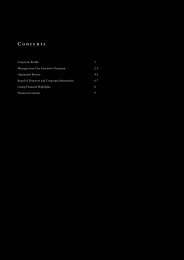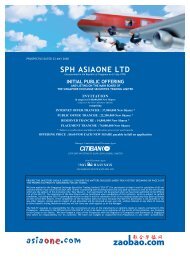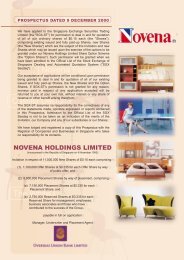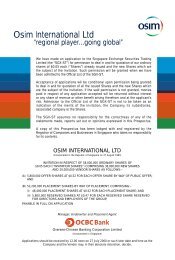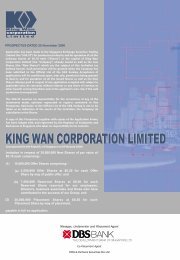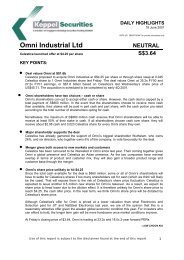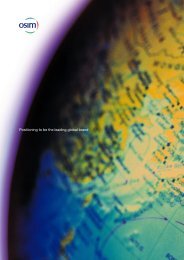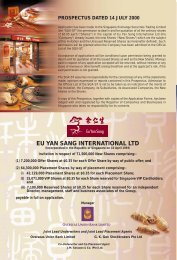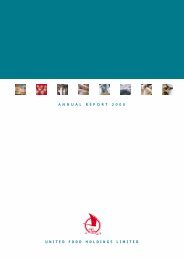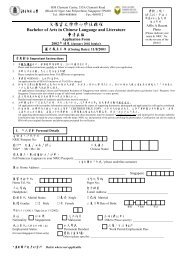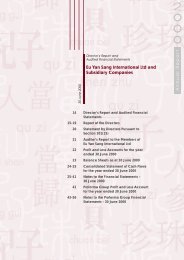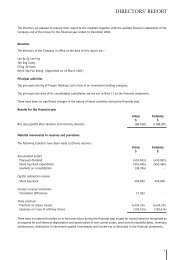ANNEX B-2: Research and Development (R&D) Tax Measures
ANNEX B-2: Research and Development (R&D) Tax Measures
ANNEX B-2: Research and Development (R&D) Tax Measures
You also want an ePaper? Increase the reach of your titles
YUMPU automatically turns print PDFs into web optimized ePapers that Google loves.
<strong>ANNEX</strong> B-2: <strong>Research</strong> <strong>and</strong> <strong>Development</strong> (R&D) <strong>Tax</strong> <strong>Measures</strong><br />
1) Liberalisation of R&D <strong>Tax</strong> Deduction<br />
a) Enhanced deduction for R&D expenses<br />
Existing <strong>Tax</strong> Treatment<br />
• Currently, taxpayers carrying on a manufacturing trade or business or a trade or business<br />
for the provision of any services enjoy tax deduction, under section 14D of the Income<br />
<strong>Tax</strong> Act, for expenses they incur on R&D 4 . The deduction is available for expenses on<br />
R&D, irrespective of whether the R&D is done in-house by the taxpayer itself or by a<br />
R&D organisation on behalf of the taxpayer, whether done in Singapore or abroad 5 .<br />
• The tax deduction under section 14D is equal to 100% of the amount of qualifying R&D<br />
expenditure.<br />
New <strong>Tax</strong> Treatment<br />
• With effect from Year of Assessment 2009, taxpayers that incur expenses in respect of<br />
R&D activities carried out in Singapore will qualify for a tax deduction of 150% of the<br />
amount of R&D expenses incurred. The 150% tax deduction will be granted to R&D<br />
which the company itself does in Singapore, or outsources to an R&D organisation in<br />
Singapore. This higher tax deduction will be available for Years of Assessment 2009 to<br />
2013.<br />
• R&D expenditure incurred in respect of R&D activities that the taxpayer has outsourced<br />
to an R&D organisation outside of Singapore will continue to qualify for deduction under<br />
section 14D. The tax deduction will, however, remain unchanged at 100% of the<br />
qualifying R&D expenditure incurred.<br />
b) Removal of “related to that trade or business” requirement under Section 14D <strong>and</strong> Section<br />
14E of Income <strong>Tax</strong> Act<br />
Existing <strong>Tax</strong> Treatment<br />
• Besides the 100% tax deduction available under section 14D of the Income <strong>Tax</strong> Act,<br />
taxpayers carrying on a manufacturing trade or business or a trade or business for the<br />
4 Section 2 of the Income <strong>Tax</strong> Act defines R&D as any systematic or intensive study carried out in the field of<br />
science or technology with the object of using the results of the study for the production or improvement of<br />
materials, devices, products, produce, or processes, but does not include —<br />
(a) quality control or routine testing of materials, devices or products;<br />
(b) research in the social sciences or the humanities;<br />
(c) routine data collection;<br />
(d) efficiency surveys or management studies; or<br />
(e) market research or sales promotion.<br />
5 Where a taxpayer pays an R&D organization overseas to do R&D on its behalf, the taxpayer is granted the tax<br />
deduction under section 14D only if the taxpayer undertakes that the benefit of the R&D to be done accrues to<br />
itself.<br />
MINISTRY OF FINANCE 48
provision of any services can also be granted a further tax deduction under section 14E on<br />
approval basis for R&D done in Singapore either by the taxpayer itself or by a R&D<br />
organisation in Singapore on its behalf. <strong>Tax</strong> deductions under section 14D <strong>and</strong> section<br />
14E are granted on the condition that the R&D done is related to the trade or business of<br />
the taxpayer.<br />
New <strong>Tax</strong> Treatment<br />
• With effect from Year of Assessment 2009, taxpayers carrying on a manufacturing trade<br />
or business or a trade or business for the provision of services will be allowed to claim<br />
deductions for R&D expenses that are not incurred in respect of their existing trade or<br />
business. These claims will, however, be subject to the condition that the R&D expenses<br />
are incurred in respect of R&D activities done in Singapore either by the taxpayer itself or<br />
by a R&D organisation in Singapore on its behalf. The change applies to both section<br />
14D <strong>and</strong> section 14E deductions, <strong>and</strong> will be effective for Years of Assessment 2009 to<br />
2013.<br />
• Expenses incurred on R&D that is outsourced to an R&D organisation outside Singapore<br />
will continue to be granted the 100% deduction under section 14D, only if the R&D done<br />
is related to the trade or business of the taxpayer.<br />
2) R&D <strong>Tax</strong> Allowance<br />
• The R&D tax allowance is a new incentive available to companies in Singapore that have<br />
chargeable income. Under the incentive, companies with chargeable income will be<br />
granted an R&D allowance for each year of assessment falling within Years of<br />
Assessment 2009 to 2013, at a prescribed rate based on the chargeable income for the<br />
year of assessment. The R&D allowance granted can be used to offset chargeable income<br />
for the next three years of assessment provided the qualifying conditions are met.<br />
• The prescribed rate at which R&D tax allowance is granted shall be 50% of the first<br />
$300,000 of a company’s chargeable income 6 or such lower amount where the company’s<br />
chargeable income 6 is less than $300,000, for each year of assessment from Year of<br />
Assessment 2009 to 2013. The maximum R&D tax allowance granted for each<br />
qualifying year of assessment is therefore $150,000 (i.e. 50% x $300,000).<br />
• The R&D tax allowance can be utilised to offset chargeable income for the next three<br />
years of assessment (following the year of assessment that it is granted), if the company<br />
incurs, in the basis periods of those three years of assessment of utilisation, qualifying<br />
R&D expenditure in excess of a base amount (i.e. incremental qualifying R&D<br />
expenditure). Any R&D tax allowance that remains unutilised as at the end of the three<br />
years of assessment will be disregarded.<br />
• Qualifying R&D expenditure refers to R&D expenditure that:<br />
- qualifies for deduction under section 14D of the Income <strong>Tax</strong> Act; <strong>and</strong><br />
- the company incurs in respect of R&D activities undertaken directly (i.e. inhouse)<br />
by the company in Singapore<br />
6<br />
Chargeable income after R&D tax allowance utilised (if any), start-up exemption (where applicable) <strong>and</strong><br />
partial tax exemption (PTE).<br />
MINISTRY OF FINANCE 49
For the purpose of computing the amount of qualifying R&D expenditure, government grants<br />
(if any) <strong>and</strong> R&D expenses which the company incurs for all outsourced R&D (whether<br />
outsourced to an R&D organisation in Singapore or abroad) will not be considered as part of<br />
the qualifying R&D expenditure.<br />
• The base amount of qualifying R&D expenditure is set at the level of the company’s<br />
qualifying R&D expenditure incurred for the base year. The fixed base year for existing<br />
companies is the basis period for Year of Assessment 2008.<br />
• R&D tax allowances cannot be transferred among related companies under group relief.<br />
• Example: Mechanics of R&D <strong>Tax</strong> Allowance Scheme<br />
Note:<br />
TAX COMPUTATION<br />
MINISTRY OF FINANCE 50<br />
YA2009 YA2010 YA2011 YA2012<br />
Chargeable income (before Partial <strong>Tax</strong><br />
Exemption (PTE)) 500,000 300,000 250,000 400,000<br />
Less: R&D <strong>Tax</strong> Allowance utilised (A)<br />
= lower of (B-C) or D 0 100,000 98,750 36,563<br />
Adjusted chargeable income before PTE 500,000 200,000 151,250 363,437<br />
Adjusted chargeable income after PTE 347,500 97,500 73,125 210,937<br />
R&D Expenses (B) 100,000 200,000 300,000 400,000<br />
Base Year R&D (C) 100,000 100,000 100,000 100,000<br />
Incremental R&D Exp (B-C) NA 100,000 200,000 300,000<br />
R&D <strong>Tax</strong> Allowance Account<br />
R&D <strong>Tax</strong> Allowance b/f:<br />
YA2009 0 150,000 50,000 0<br />
YA2010 0 0 48,750 0<br />
YA2011 0 0 0 36,563<br />
Total R/D <strong>Tax</strong> Allowance b/f (D) 150,000 98,750 36,563<br />
Less: R&D <strong>Tax</strong> Allowance utilised (A) 0 -100,000 -98,750 -36,563<br />
Add: Current year R&D <strong>Tax</strong> Allowance (E)<br />
= 50% * adjusted chargeable income after PTE 150,000 48,750 36,563 105,469<br />
R&D <strong>Tax</strong> Allowance c/f = D-A+E 150,000 98,750 36,563 105,469<br />
A = Utilisation of R&D tax allowance is capped at the lower of incremental R&D expenses<br />
or the R&D tax allowance brought forward (i.e. excluding R&D tax allowance earned in<br />
current YA).<br />
B = This refers to the actual amount of R&D expenses incurred, <strong>and</strong> not the quantum of the<br />
tax deduction.<br />
C = R&D expenses incurred in basis period for YA2008 i.e. financial year 2007.<br />
D = Unutilised R&D <strong>Tax</strong> Allowance brought forward from up to the preceding 3 YAs.
E = Capped at 50% of the first $300,000 chargeable income (after R&D tax allowance<br />
utilised (if any), start-up exemption (where applicable) <strong>and</strong> partial tax exemption (PTE)), or<br />
such lower amount where the chargeable income (after R&D tax allowance utilised (if any),<br />
start-up exemption (where applicable) <strong>and</strong> partial tax exemption (PTE)) is less than $300,000<br />
3) R&D Incentive for Start-up Enterprises (RISE)<br />
• This is a new incentive which provides government grants to R&D-intensive start-ups that<br />
do not generate taxable profits in their first three years of assessment, subject to qualifying<br />
conditions.<br />
• R&D-intensive start-ups invest a significant amount of R&D into developing their<br />
products. It often takes time for these products to generate profits, so the start-ups may not<br />
have chargeable income in the initial years. For start-ups who do not yet have chargeable<br />
income, they are unable to benefit from R&D tax incentives such as the R&D tax<br />
allowance. For tax purposes, these start-up companies are allowed to carry forward their<br />
losses currently. Nonetheless, this carry-forward of losses may not be of immediate<br />
assistance to ease the cashflow challenges these R&D-intensive start-ups may face in their<br />
initial years.<br />
• To make Singapore more attractive for R&D-intensive start-ups <strong>and</strong> to encourage start-up<br />
companies to invest more in building up their in-house R&D capabilities in Singapore, the<br />
R&D Incentive for Start-up Enterprises (RISE) will be introduced.<br />
• Under RISE, a qualifying start-up company is allowed to convert up to $225,000 7 of tax<br />
losses into cash computed at a prescribed rate, if it spends at least $150,000 expenses on<br />
ongoing R&D done in Singapore in the basis period for the year of assessment of claim.<br />
• The start-up can therefore choose either to convert its losses in exchange for cash under<br />
the RISE scheme, or carry forward the losses for offset against its subsequent chargeable<br />
income in future years of assessment. If the start-up company chooses to convert its<br />
losses under RISE into cash instead of carrying forward the losses, the losses of the startup<br />
company to be carried forward will be correspondingly reduced by the amount of the<br />
converted losses.<br />
• Qualifying start-up companies can claim for cash grants under RISE for Years of<br />
Assessment 2009 to 2013.<br />
• To qualify for RISE, the start-up company needs to meet all of the following conditions:<br />
a) It satisfies the criteria for the general start-up corporate tax exemption, that is, it is a<br />
company that:<br />
(i) is incorporated in Singapore;<br />
(ii) is tax resident of Singapore;<br />
(iii) has total share capital which is beneficially held, directly or indirectly,<br />
by no more than 20 persons –<br />
(1) all of whom are individuals, or<br />
7 This is 150% of $150,000 of R&D expenditure, in view of the concession to allow deduction of 150% of<br />
expenses incurred on R&D carried out in Singapore.<br />
MINISTRY OF FINANCE 51
(2) of which at least one is an individual shareholder holding at least<br />
10% of total number of issued ordinary shares throughout the basis<br />
period relating to the years of assessment of claim.<br />
b) Its first three years of assessment fall within the period of Years of Assessment<br />
2009 to 2013;<br />
c) It does not have taxable profits or chargeable income in all preceding years prior to<br />
the year of assessment of claim;<br />
d) It incurs at least $150,000 qualifying expenditure on R&D in the basis period for<br />
the year of assessment of claim.<br />
• Qualifying Expenditure on R&D means:<br />
(a) Expenditure which the company incurs on R&D that the company undertakes directly (inhouse)<br />
in Singapore. Expenditure on R&D that is funded by government grants (if any) or<br />
expenditure that the company incurs for R&D outsourced to a R&D organisation (whether in<br />
Singapore or abroad) will not be considered as part of qualifying expenditure on R&D (i.e.<br />
will be netted off from the total R&D expenditure incurred); <strong>and</strong><br />
(b) The R&D concerned must still be on-going at the time of claim<br />
• The amount of cash grant that a qualifying start-up company can claim for a year of<br />
assessment (during Years of Assessment 2009 to 2013) will be computed based on the<br />
prescribed rate as follows:<br />
• Amount of tax losses that can be converted is the lower of -<br />
(a) the actual losses for the year of assessment of claim; or<br />
(b) the tax deduction for up to $150,000 qualifying R&D expenditure<br />
incurred in the basis period for the year of assessment of claim.<br />
Hence, the maximum amount of losses that can be converted is $225,000 for<br />
each year of assessment of claim.<br />
• Amount of cash grant equals 9% x the amount of losses to be converted. The<br />
maximum amount of cash grant is thus $20,250 for each year of assessment of<br />
claim.<br />
The 9% rate is equivalent to the effective marginal tax rate for companies with chargeable<br />
income between $10,000 - $300,000 (taking into account the prevailing partial tax exemption<br />
of 50% for this chargeable income range).<br />
IRAS will release further implementation details (including anti-avoidance measures) for the<br />
above R&D tax changes by September 2008.<br />
MINISTRY OF FINANCE 52
WORKED EXAMPLES OF THE R&D TAX ALLOWANCE AND 150% TAX<br />
DEDUCTION<br />
Example 1<br />
Company has accounting profits of $300,000 in Year 1. It did not do any R&D.<br />
In Year 2, it incurred incremental R&D spending of $150,000, <strong>and</strong> its accounting profit is<br />
$150,000. The R&D expenditure relates to R&D that the company itself carried out in<br />
Singapore.<br />
<strong>Tax</strong> Computation:<br />
Year 1 Year 2<br />
Net profit per accounts (A) 300,000 150,000<br />
Add: R&D expenditure 0 150,000<br />
300,000 300,000<br />
Less: R&D deductions 0 (225,000) Note 1<br />
Less: R&D <strong>Tax</strong> Allowance utilised (73,750)<br />
Chargeable Income 300,000 1,250<br />
Less: Partial <strong>Tax</strong> Exemption (152,500) (938) Note 2<br />
Adjusted chargeable income 147,500 312<br />
<strong>Tax</strong> payable @ 18% (B) 26,550 56<br />
Effective tax rate (B)/(A) 8.85% 0.04%<br />
Current YA’s R&D <strong>Tax</strong> Allowance<br />
c/f 73,750 156<br />
Note 3<br />
<strong>Tax</strong> savings from R&D incentives 26,494 Note 4<br />
Note 1: 150% of expenditure incurred for R&D done in Singapore.<br />
Note 2: 75 % of the first $10,000 <strong>and</strong> 50% of up to the next $290,000 of the company’s<br />
chargeable income is exempt.<br />
Note 3: Current YA’s R&D <strong>Tax</strong> Allowance (RDA) is computed at 50% of the chargeable income<br />
after partial tax exemption (i.e. adjusted chargeable income in the table above), up to a<br />
maximum of $150,000 of RDA per YA<br />
Note 4: The tax savings is the difference between the taxes it would have paid without the R&D<br />
tax deductions <strong>and</strong> R&D <strong>Tax</strong> Allowance ($26,550) <strong>and</strong> the tax payable for Year 2 ($54).<br />
53
Example 2<br />
Company has accounting profits of $1,000,000 in Year 1. It did not do any R&D.<br />
In Year 2, it incurred incremental R&D spending of $150,000, <strong>and</strong> its accounting profit is<br />
$850,000. The R&D expenditure relates to R&D that the company carried out in Singapore.<br />
<strong>Tax</strong> Computation:<br />
Year 1 Year 2<br />
Net profit per accounts (A) 1,000,000 850,000<br />
Add: R&D expenditure 0 150,000<br />
1,000,000 1,000,000<br />
Less: R&D deductions 0 (225,000) Note 1<br />
Less: R&D <strong>Tax</strong> Allowance (150,000)<br />
Chargeable Income 1,000,000 625,000<br />
Less: Partial <strong>Tax</strong> Exemption (152,500) (152,500) Note 2<br />
Adjusted chargeable income 847,500 472,500<br />
<strong>Tax</strong> payable @ 18% (B) 152,550 85,050<br />
Effective tax rate (B)/(A) 15.26% 10.01%<br />
Current YA’s R&D <strong>Tax</strong> Allowance c/f 150,000 150,000 Note 3<br />
Value of savings from R&D incentives 67,500 Note 4<br />
Note 1: 150% of expenditure incurred for R&D done in Singapore.<br />
Note 2: 75 % of the first $10,000 <strong>and</strong> 50% of up to the next $290,000 of the company’s<br />
chargeable income is exempt.<br />
Note 3: Current YA’s R&D <strong>Tax</strong> Allowance (RDA) is computed at 50% of the chargeable income<br />
after partial tax exemption (i.e. adjusted chargeable income in the table above), up to a<br />
maximum of $150,000 of RDA per YA<br />
Note 4: The tax savings is the difference between the taxes it would have paid without the R&D<br />
tax deductions <strong>and</strong> R&D <strong>Tax</strong> Allowance ($152,550) <strong>and</strong> the tax payable for Year 2<br />
($85,050).<br />
MINISTRY OF FINANCE 54



